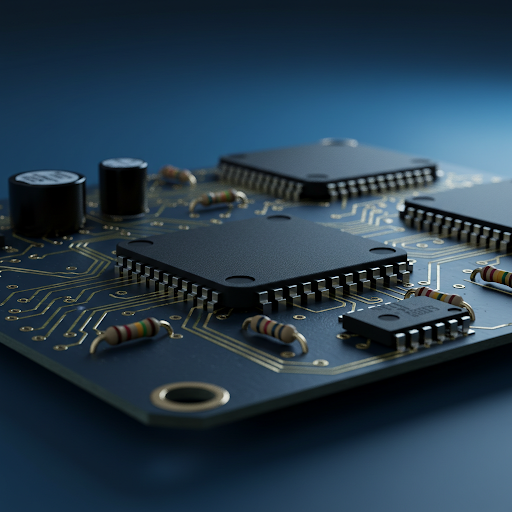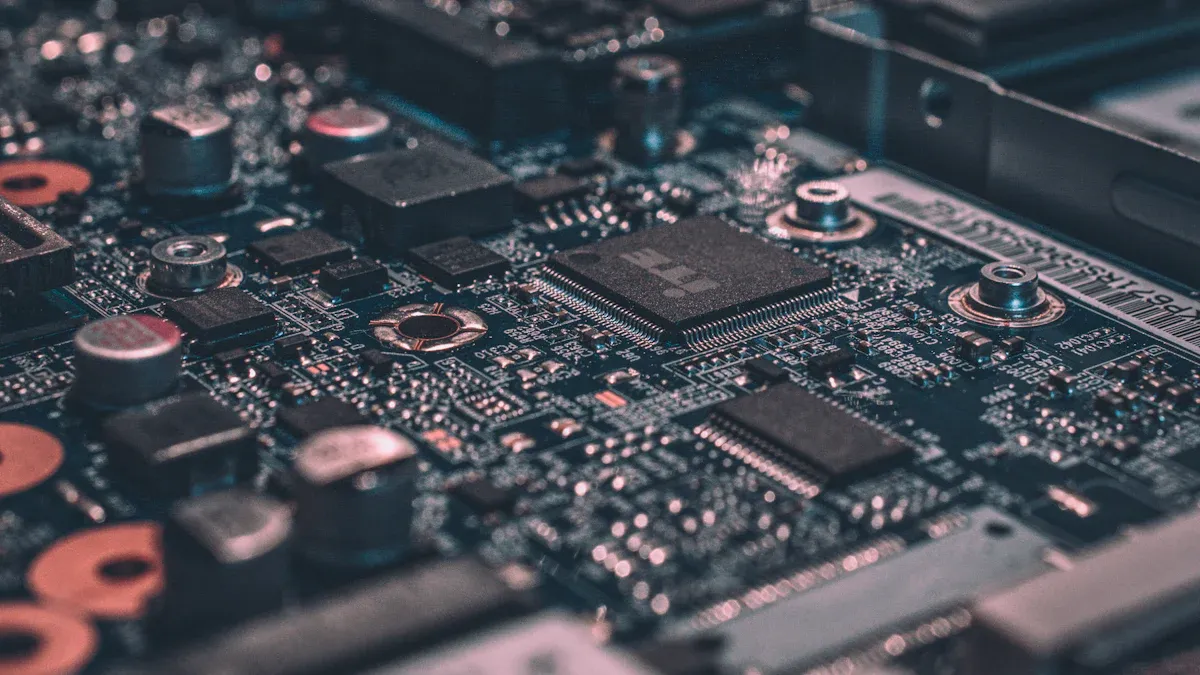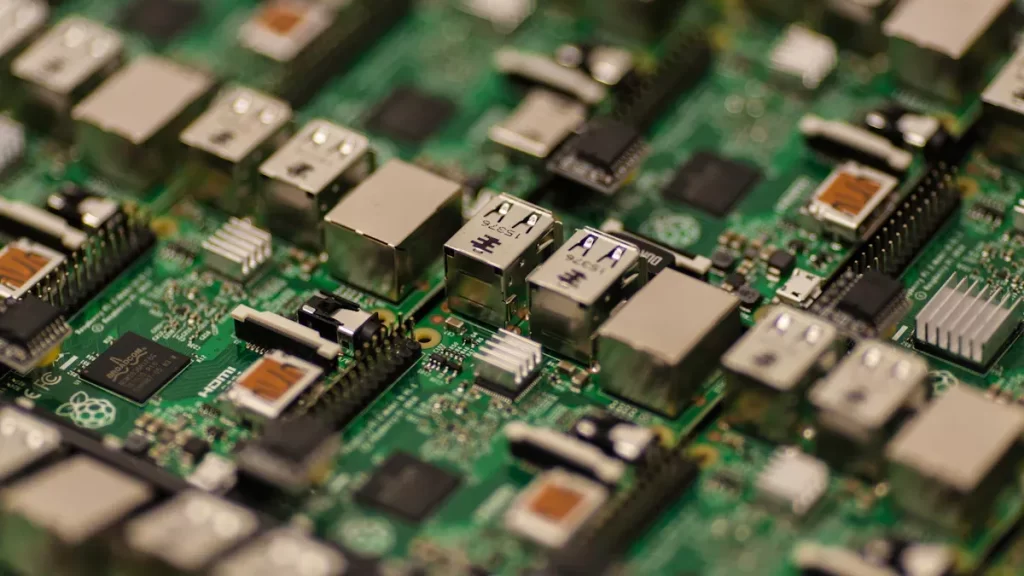
Ruggedized IIoT PCB assembly services provide strong circuit boards designed for tough conditions. These ruggedized PCBs perform exceptionally well even in extreme heat, cold, or wet environments. For instance, robust designs and specialized coatings prevent damage from rust or electrical interference. In the realm of IIoT, ruggedized PCBs facilitate safe and seamless operations, enabling reliable communication and efficient data handling. Their durable construction ensures that industries remain operational and minimizes delays, making them essential for modern industrial systems.
Key Takeaways
Ruggedized PCBs are made to handle tough conditions. They work well in places like factories and outdoors.
Special heat control in ruggedized PCBs stops overheating. This makes devices last longer and work better.
These PCBs block moisture, dust, and shaking. They are great for cars, healthcare tools, and airplanes.
Adding sensors to ruggedized PCBs helps check systems in real-time. This finds problems early and stops bigger failures.
Picking ruggedized PCBs with safe and green materials helps systems work better and protects the planet.
Key Features of Ruggedized PCBs

Durability and Resistance to Environmental Factors
Ruggedized PCBs are made to handle tough conditions. Their strength comes from special materials and protective layers. For example, conformal coatings protect them from chemicals, water, and extreme heat or cold. These coatings help the boards work well in places like military missions, space travel, or rescue operations.
Tests like MIL-STD-810F prove their toughness. These tests copy real-world challenges like high altitudes, extreme temperatures, and strong impacts. They also check if the PCBs can handle rain, humidity, and salty air. This testing ensures ruggedized PCBs work in harsh environments without failing.
In underwater or high-pressure jobs, ruggedized PCBs perform well. They resist rust from water and stay strong under pressure. This makes them perfect for industries needing reliable tools in hard conditions.
Advanced Thermal Management and Heat Dissipation
Heat can damage electronic systems quickly. Ruggedized PCBs solve this with smart heat control methods. Studies show bad heat control can lower system reliability by 30%. To stop this, these PCBs use thick copper lines that move heat away from key parts.
Heat sinks made of aluminum or copper help cool the system more. These sinks spread heat over a larger area, stopping overheating. New cooling systems have cut temperatures by up to 30% in high-performance uses. This keeps ruggedized PCBs working well, even in very hot places.
Protection Against Moisture, Dust, and Vibration
Factories and other places often expose PCBs to water, dust, and shaking. Ruggedized PCBs fight these problems with special designs. Coatings and potting methods keep water and dust out. This stops rust and short circuits that could break the device.
They are also built to handle vibrations. Shock tests make sure ruggedized PCBs can take hits without breaking. This makes them great for use in vehicles, big machines, and other shaky environments. With these protections, ruggedized PCBs work reliably in tough conditions.
Use of Strong Materials and Protective Coatings
Strong materials and coatings are key to ruggedized PCBs’ durability. These special materials help the boards survive tough industrial conditions. They resist rust, physical damage, and other environmental problems. This makes them important for industries needing safe and reliable systems.
Ruggedized PCBs go through strict tests to meet standards:
UL tests check if they follow global safety rules.
Reliability tests see how they handle heat, shaking, and noise.
Certifications prove they work well in hard situations.
Protective coatings make ruggedized PCBs even tougher. Conformal coatings block water, dust, and chemicals. These coatings act like armor, stopping damage that could cause failures. Potting compounds add extra protection by covering parts. This helps the boards survive shocks and vibrations.
In factories and power plants, ruggedized PCBs must work nonstop. Strong materials keep them running in harsh places. For over 50 years, testing has improved PCB strength and safety. These tests ensure ruggedized PCBs meet strict rules and work well in IIoT systems.
Using ruggedized PCBs with high-quality materials improves system reliability. This keeps your operations running smoothly, even in tough environments.
Role of Ruggedized PCBs in IIoT Applications
Helping Predict Problems and Monitor in Real-Time
Ruggedized PCBs are important for spotting problems early and monitoring equipment in real-time. Sensors built into the PCBs check things like temperature, pressure, or vibration. These sensors warn you about issues before they cause failures. This helps you fix problems early, saving time and money.
In factories, ruggedized PCBs work with sensors and controllers. This teamwork keeps machines running smoothly and allows automatic repairs. It also makes your equipment last longer. By using data to predict problems, you can improve how your systems work and make them more reliable.
Tip: Adding advanced sensors to ruggedized PCBs can make your maintenance smarter and more efficient.
Improving Processes and Making Work Easier
Ruggedized PCBs help industries work better and faster. Their strong design keeps them working even in tough places. This means fewer delays and more productivity.
Here’s how ruggedized PCBs improve different industries:
Industry | Key Benefits | Example |
|---|---|---|
Automotive | Fewer defects and faster production | Case Study 1: Car Electronics Company |
Medical Devices | Better product quality | Case Study 2: Medical Startup |
Industrial Control | Quicker product delivery | Case Study 3: Industrial IoT Business |
In factories, ruggedized PCBs connect easily with sensors and other parts. This connection helps control machines better, reducing mistakes and boosting efficiency. Whether making cars or medical tools, ruggedized PCBs ensure smooth operations.
Boosting Connections and Data Sharing in Factories
In IIoT, sharing data and staying connected is very important. Ruggedized PCBs keep devices talking to each other, even in tough conditions. Their strong build stops problems from water, dust, or shaking, keeping data flowing smoothly.
With advanced sensors and communication tools, ruggedized PCBs share data instantly across your network. This helps you make better decisions and improves how your systems work. For example, in factories, these PCBs help machines communicate, making work faster and more organized.
Note: Good connections are key for IIoT systems. Ruggedized PCBs make sure your data stays safe and flows smoothly, even in hard environments.
Ensuring reliability in mission-critical systems
In critical systems, being reliable is a must-have feature. These systems work in places where failure can cause big problems. Issues like money loss, safety risks, or work delays can happen. Ruggedized PCBs help these systems work well, even in tough conditions.
You depend on ruggedized PCBs to keep things steady in important tasks. Their strong build and smart features make them perfect for fields like space, health, and factories. For example, in space, ruggedized PCBs keep communication working during high flights. In health, they power life-saving machines without stopping.
One reason they are so reliable is their toughness. These PCBs handle temperature changes, water, and hard hits. Such challenges are common in industrial jobs. Using strong materials and special coatings, ruggedized PCBs avoid damage. This strength keeps your critical systems running when needed most.
Another key point is their role in safe data sharing. In IIoT, ruggedized PCBs help devices talk to each other smoothly. They use secure methods to protect data from hackers. This is very important for industries with private information.
Ruggedized PCBs also stay cool with advanced heat control. Heat can harm parts over time and cause breakdowns. These PCBs use heat sinks and special paths to remove heat. This keeps systems cool and working longer, even in demanding jobs.
Adding ruggedized PCBs to your IIoT systems gives you peace of mind. They handle hard conditions, protect data, and manage heat well. This makes them a must-have for critical tasks. Choosing ruggedized PCBs means your systems will work reliably, no matter the challenges.
Tip: Check and maintain your ruggedized PCBs often. This helps them stay reliable and keeps your critical systems running smoothly.
Design Tips for Strong IIoT PCB Assembly
Picking Materials for Strength and Good Performance
Choosing the right materials is very important for tough PCBs. The materials must handle rough conditions and still work well. For regular IoT devices, FR-4 laminates are affordable and work fine. But for better signal quality, Rogers laminates are a smarter pick.
Testing helps check if materials are strong enough. Tests like In-Circuit Testing (ICT) make sure connections work. Functional Testing (FT) checks if the PCB does its job. Environmental Stress Testing (EST) copies real-world challenges to test toughness. These tests help find the best materials for rugged PCBs.
When picking materials, look at electrical features like Dk (dielectric constant) and Df (dissipation factor). Lower Dk/Df values mean less signal loss, which is great for fast designs. Always trust test results over what suppliers claim for accurate choices.
Meeting Safety and Industry Rules
Rugged PCBs must follow strict safety and industry rules. These rules make sure your PCBs are safe and high-quality. Certifications like ISO and IPC prove your PCBs meet global standards.
Advanced tests also check if PCBs follow rules. Automated Optical Inspection (AOI) finds defects, and X-ray tests spot hidden problems. ICT ensures all parts work properly. These tests confirm your PCBs can handle tough industrial jobs.
By following these rules, you can trust your PCBs to work safely and well, even in hard conditions.
Keeping Cool and Saving Power
Good heat control is key for rugged PCBs. Too much heat can break systems. You can improve cooling by using thermal vias, copper layers, and smart part placement.
A 4-layer PCB cools better than a 2-layer one. It can handle 30% more heat. Adding airflow can also cut the space needed for cooling by half.
Planning these cooling tricks early avoids costly fixes later. This keeps your PCBs working well, even in tough environments.
Customization for specific IIoT use cases
Ruggedized PCBs can be adjusted to fit different IIoT needs. Customizing them helps systems work well in tough places. Changing the design and features makes them more reliable and useful.
One way to customize is by picking the right materials. For example, strong laminates handle heat in oil and gas jobs. Flexible PCBs are better for small medical devices. Choosing good materials keeps them strong and working well.
Another way is to design PCBs for specific sizes. Small boards fit tight spaces, while big ones hold more parts. Custom shapes make them work better and stay efficient.
Special coatings can protect PCBs from damage. Conformal coatings block water and dust, great for outdoor use. Potting compounds stop damage from shaking, perfect for cars or planes.
Tip: Talk with your PCB maker to match the design to your needs. Clear plans lead to better results.
Customizing ruggedized PCBs makes your IIoT systems last longer. It keeps devices working, even in hard conditions.
Future Trends and Advancements in Ruggedized PCBs for the Industrial Internet of Things
Integration of advanced materials and technologies
Industries need better materials for ruggedized PCBs as they use 5G and HDI. These materials help signals stay clear and manage heat well. For example, 5G networks need PCBs with low dielectric constants and high thermal conductivity to work properly.
Rigid-flex PCBs are becoming more popular. They are strong and bendable, making them great for aerospace, medical, and electronics. Cars also push new designs, especially for electric vehicles and driver-assistance systems. Special materials keep these PCBs working in tough conditions.
Note: Europe focuses on eco-friendly and high-quality designs, encouraging new materials and ideas.
Segment | Key Insights |
|---|---|
Non-metal Segment | Growing fast due to radar systems in defense. |
Airborne Segment | Leads the market with lightweight electronics and aircraft updates. |
Communication Systems Segment | High-speed systems are key, especially in C5ISR applications. |
Miniaturization and increased functionality
Smaller designs are changing how ruggedized PCBs are made, especially for IIoT devices. System-in-Package (SiP) technology combines many functions into tiny spaces. This cuts PCB size by up to 50%, making devices smaller and easier to carry.
New stacking methods like semi-additive and fully additive processes allow complex designs. These designs handle faster data and more features. Materials are also improving, with lower CTE dielectric materials helping high-speed systems work better.
Challenge/Advancement | Description |
|---|---|
Miniaturization | Smaller PCBs make devices portable. |
Complex Stacking | Advanced methods create detailed designs. |
Material Development | Better materials improve high-speed performance. |
Improved sustainability and eco-friendly designs
Making ruggedized PCBs greener is now a big focus. Manufacturers are using eco-friendly materials and designs that last longer and can be recycled. For example, studies show smartwatches have a big environmental impact. Better recycling and durability can reduce waste and help the planet.
Lifecycle assessments check energy use, emissions, and material effects during a product’s life. This helps manufacturers make choices that are better for the environment.
Component | Description |
|---|---|
Goal and Scope Definition | Sets the purpose and limits of the assessment. |
Lifecycle Inventory (LCI) | Tracks energy, emissions, and materials used in the product’s life. |
Lifecycle Impact Assessment | Measures environmental effects based on collected data. |
Interpretation | Reviews results to improve sustainability decisions. |
Tip: Use eco-friendly materials and designs to follow trends and lower environmental harm.
Enhanced compatibility with emerging IIoT technologies
New IIoT technologies need devices, systems, and networks to work together easily. Ruggedized PCBs help make this happen by supporting advanced communication methods. They let devices share data smoothly, keeping your systems ready for future updates.
One way ruggedized PCBs improve compatibility is by working with different connection types. Whether it’s Wi-Fi, Bluetooth, or 5G, these PCBs ensure devices communicate without problems. For instance, in smart factories, devices with ruggedized PCBs connect to sensors, controllers, and cloud systems seamlessly.
Another benefit is their ability to handle various power needs. Many IIoT devices use low power to save energy. Ruggedized PCBs are built to work well under these limits. This makes them perfect for battery-powered tools like remote sensors or wearable devices.
Ruggedized PCBs also include strong security features to protect data. They use encrypted communication and secure boot systems to block cyberattacks. This is crucial for industries like healthcare or finance that deal with private information.
Tip: Pick PCBs that support the newest standards and security features. This ensures your systems stay updated with changing technology.
By using ruggedized PCBs, your IIoT systems stay compatible with new technologies. Their tough design, flexibility, and safety features make them a smart choice for modern industries.
Ruggedized PCBs are key to improving IIoT systems. They keep industrial operations steady and effective, even in tough conditions. Their strength and reliability make them crucial for industries needing dependable tools. As technology grows, these PCBs will support new ideas, helping create smarter and greener industrial solutions. Using ruggedized PCBs gets your systems ready for the future of IIoT.
FAQ
What makes ruggedized PCBs different from standard PCBs?
Ruggedized PCBs are built with tougher materials and special coatings. They are designed to handle heat, water, and shaking. This makes them perfect for tough industrial jobs. Standard PCBs don’t have these features and can break in harsh places.
How do ruggedized PCBs improve IIoT system reliability?
Ruggedized PCBs stay strong against dust, water, and temperature changes. They last longer and need less fixing, keeping IIoT systems running smoothly. Even in hard conditions, they work without stopping.
Can ruggedized PCBs support advanced IIoT technologies like 5G?
Yes, ruggedized PCBs work well with new tech like 5G. They are made with advanced materials to handle fast data sharing. This keeps IIoT systems connected and working efficiently.
Are ruggedized PCBs eco-friendly?
Many ruggedized PCBs are now made with the planet in mind. They use materials that can be recycled and processes that save energy. This helps reduce waste while keeping them strong and reliable.
What industries benefit most from ruggedized PCBs?
Industries like cars, planes, healthcare, and factories use ruggedized PCBs a lot. These boards work well in places with heavy shaking or extreme weather. Standard PCBs wouldn’t last in these tough environments.
Tip: Pick ruggedized PCBs that match your industry’s needs for the best results.
See Also
The Importance of PCBA Manufacturing for IoT Devices Today
Exploring Sub PCBA Uses in Consumer Electronics and More
The Significance of PCBA in Industrial Automation Explained
The Impact of PCBA on Today’s Industrial Automation Systems
Essential Technologies Shaping PCBA Manufacturing in Consumer Electronics





